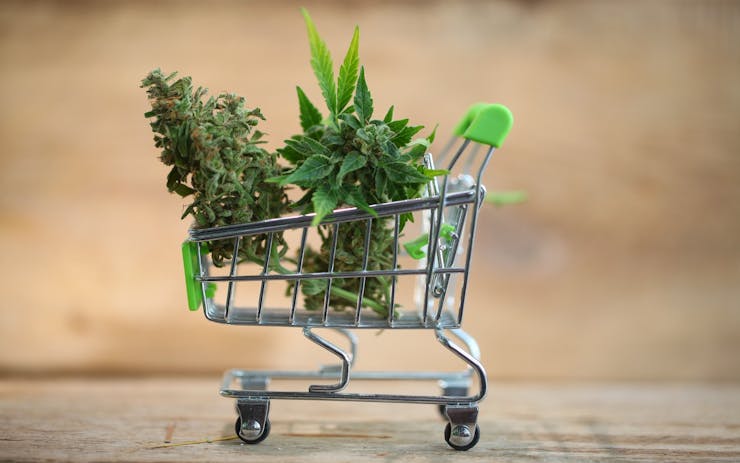In a year confined and defined by the coronavirus pandemic, Americans turned to cannabis in record numbers.
Americans spent more than $18 billion on cannabis in 2020. That’s 71% more than last year.
State tax and revenue data acquired and analyzed by Leafly reveal that nationwide sales of medical and adult-use marijuana increased by 71% over 2019.
Americans purchased $18.3 billion in cannabis products over the past calendar year, $7.6 billion more than the $10.7 billion in sales the previous year.
Medical marijuana is now legal in 37 states, while 15 states and Washington, DC, have legalized cannabis for all adults.
The pandemic effect
When the Covid-19 pandemic hit the United States in March, many in the cannabis industry worried about a massive industry-wide shutdown. Instead, governors in most states declared cannabis an essential product. Dispensaries and retail stores responded by offering online ordering, curbside pickup, and delivery as Covid-safe options for their customers.
Customers, in turn, responded by stocking up for those weeks of stay-at-home advisories. After a brief dip in late-March revenue, most stores saw a significant bump in April—and then the bump became a plateau.
Even in Massachusetts, where Gov. Charlie Baker’s statewide shutdown order temporarily halted all retail operations in April, cannabis stores posted a 75% annual sales gain over 2019. Retailers there will sell roughly $700 million in cannabis products by the end of 2020, compared to $400 million in 2019.
Online ordering and curbside pickup saved the industry

Customers bought 33% more
New consumers and patients, and newly legal states, played a role in 2020’s cannabis boom. But the main driver was an increase in the average purchase size of established consumers, who increased their average monthly spends by 33%.
Cannabis data analysts at Headset and CannaCraft recently analyzed the demographics of monthly cannabis sales in California. The graph they came up with perfectly captured the pandemic-led buying trend in both California and the nation:

Coping with pandemic stress
This year’s sales figures will come as no surprise to retailers, who’ve heard firsthand about the importance of cannabis in the lives of their customers, especially since the pandemic hit in March.
In October, multi-state dispensary operator Verilife surveyed more than 2,000 Americans and found that 72% of respondents named the Covid-19 pandemic as the leading cause of stress and burnout in their lives this year. Nearly 40% said they have used cannabis to cope with that burnout. Around 37% said they have used CBD, and a further 29% said they have considered using marijuana to lower their stress level this year.

Nine states more than doubled sales
Nine state more than doubled their 2019 sales totals in 2020: Arkansas, Connecticut, Florida, Illinois, Maine, New Jersey, North Dakota, Ohio, and Pennsylvania.
Florida emerged as the nation’s fourth-largest cannabis market in 2020. With more than $1.2 billion in sales, the medical marijuana state trailed only top adult-use states California, Colorado, and Washington.
Florida and New York: A tale of two states
This year’s sales data also reveal the importance of state regulations when it comes to patient access and industry success.
Florida and New York have roughly comparable populations—around 20 million people—but their medical marijuana markets have evolved in radically different directions.
New York has licensed only 38 dispensaries, a comically low number for a state with 20 million people. Florida, by contrast, has 300 dispensaries operating to serve a similar population. New York has never allowed cannabis flower to be sold, while flower now makes up roughly half of all medical marijuana sales in Florida.
The result: Florida has four times as many registered patients as New York and has recorded more than ten times the sales revenue in 2020.
Cannabis sales data: Not always straightforward
Leafly arrived at its 2020 sales figure of $17.9 billion by analyzing state-by-state sales figures.
Some states, like Massachusetts, post clear and accurate monthly revenue data on public websites. Many others keep murky records or post indirect sales metrics, such as pounds of cannabis flower sold. In those cases, Leafly analysts reverse-engineer state cannabis tax revenue data and consult with local dispensary managers to arrive at a reasonable estimate of flower prices and market percentages.
For late-December sales figures, we estimated the final weeks of sales by assuming an average of the past three months of revenue figures.
Leafly will publish a full accounting of 2020’s state-by-state sales figures as part of our annual Cannabis Jobs Report in February.
Editor’s note
This article was updated on Feb. 1, 2021, to reflect revised and final 2020 sales figures from various states.





